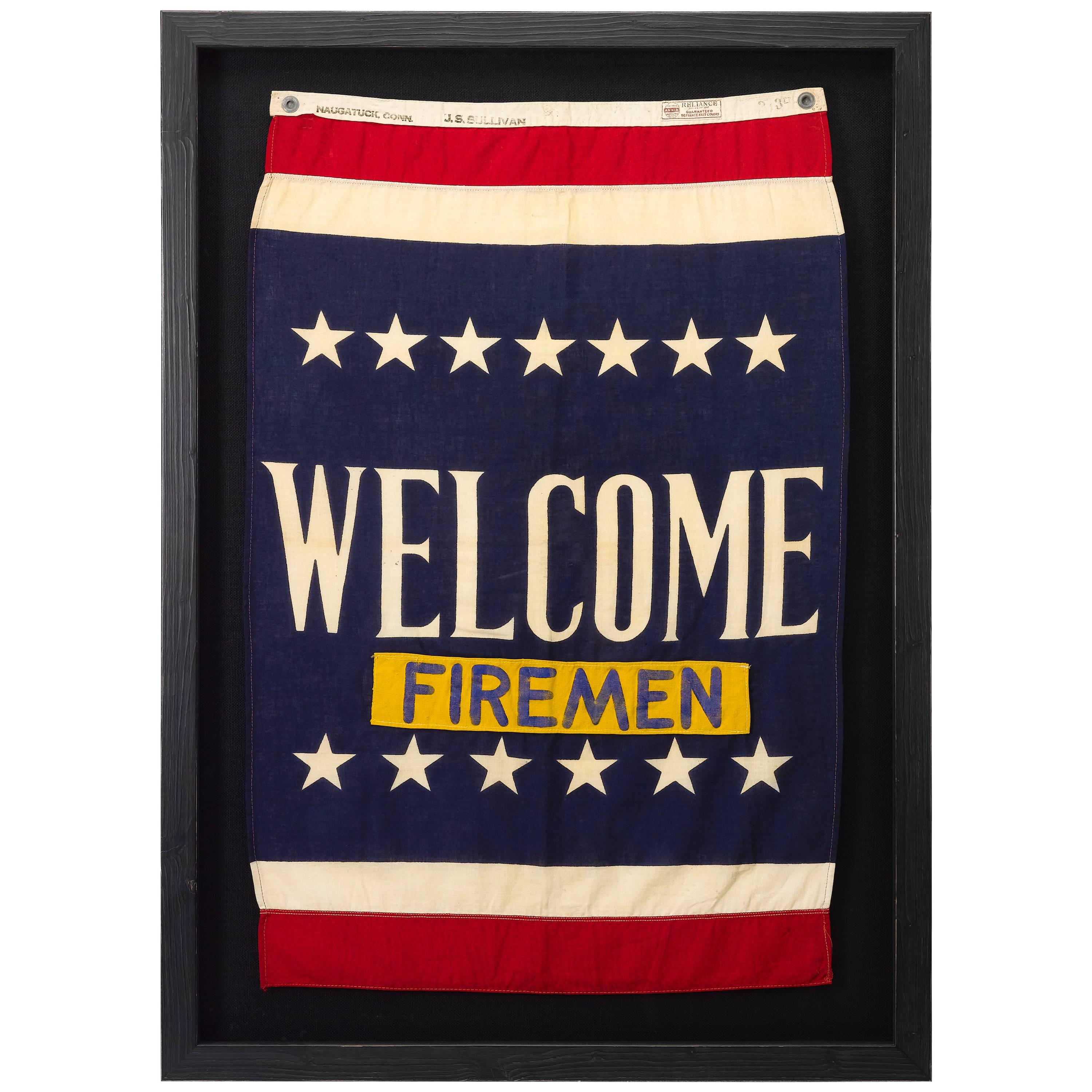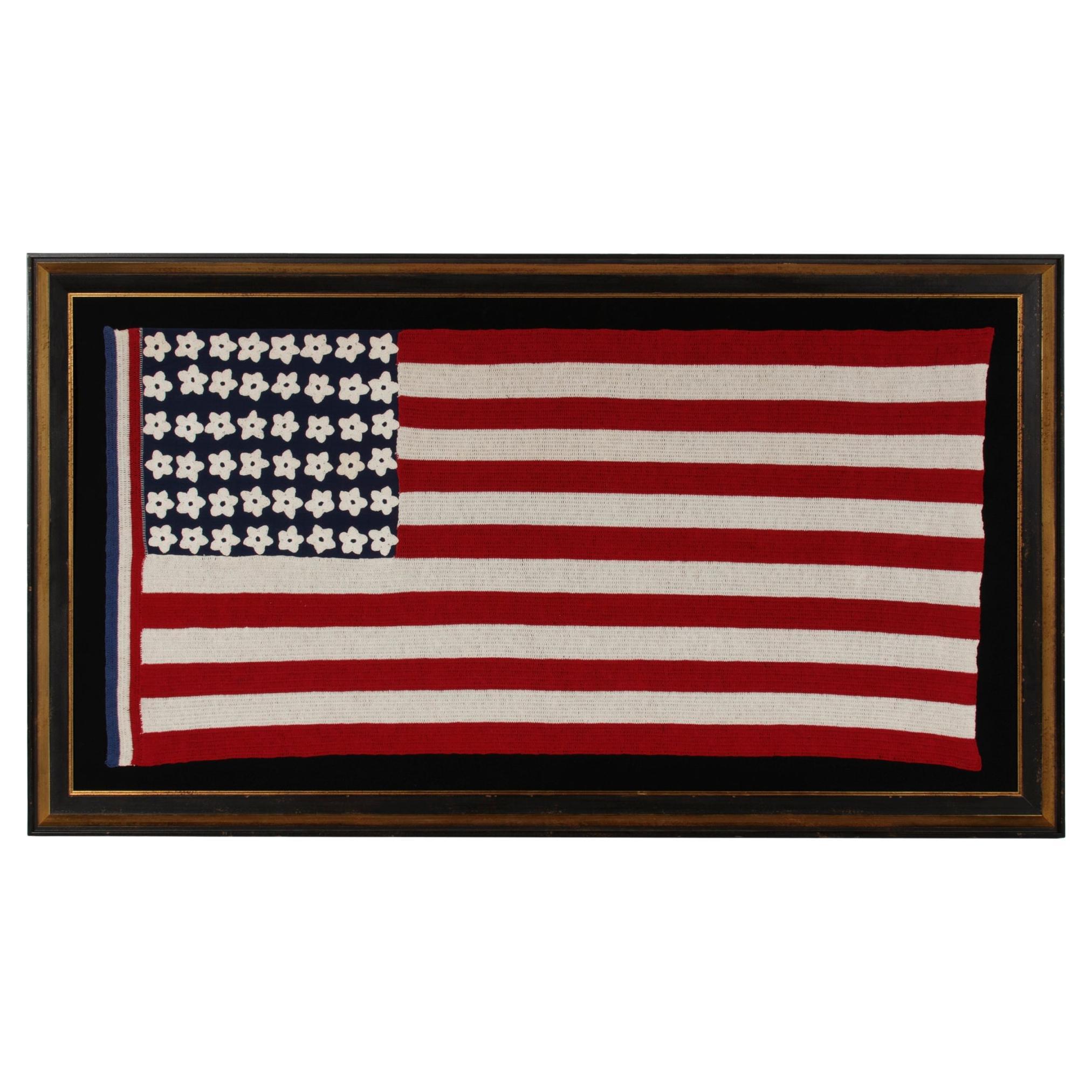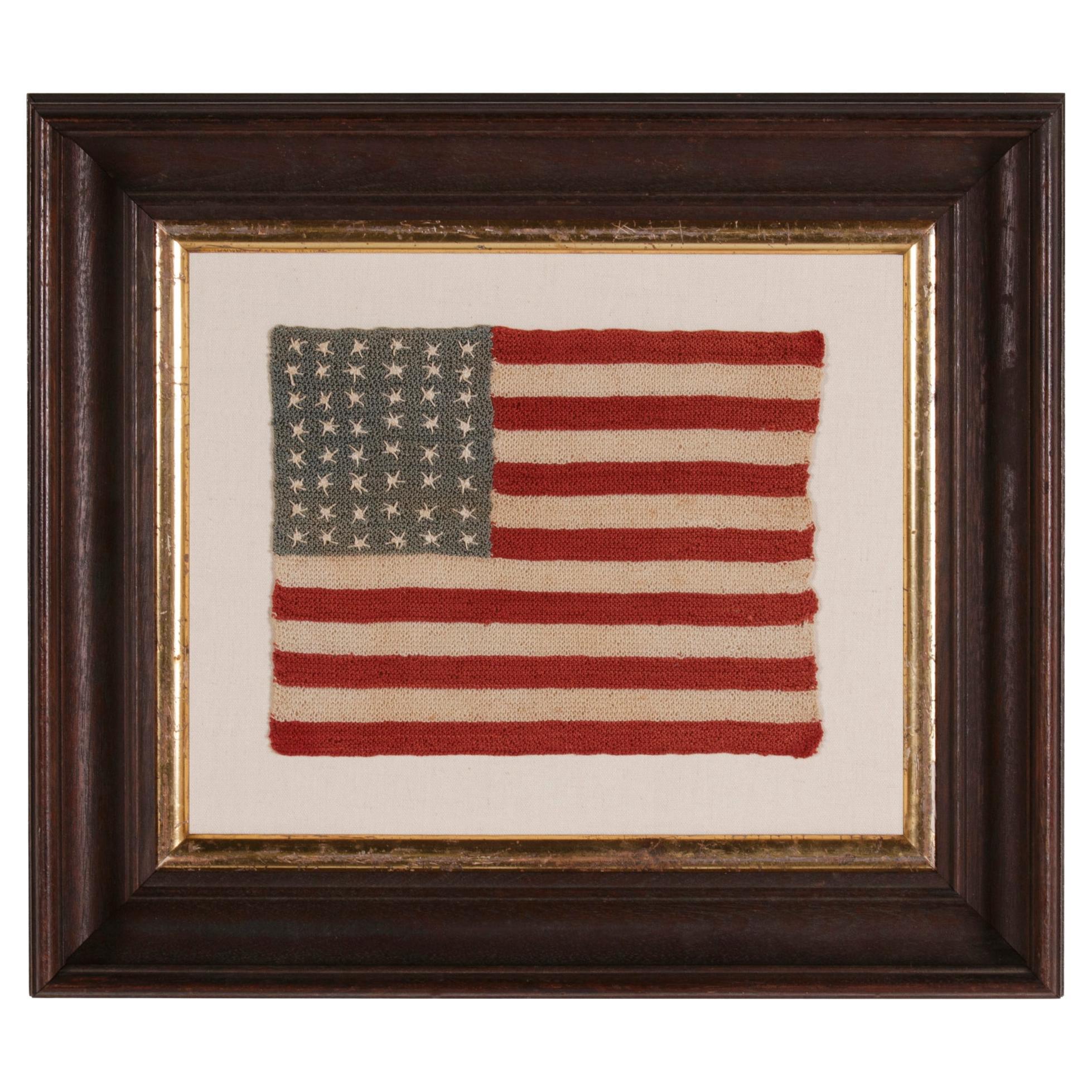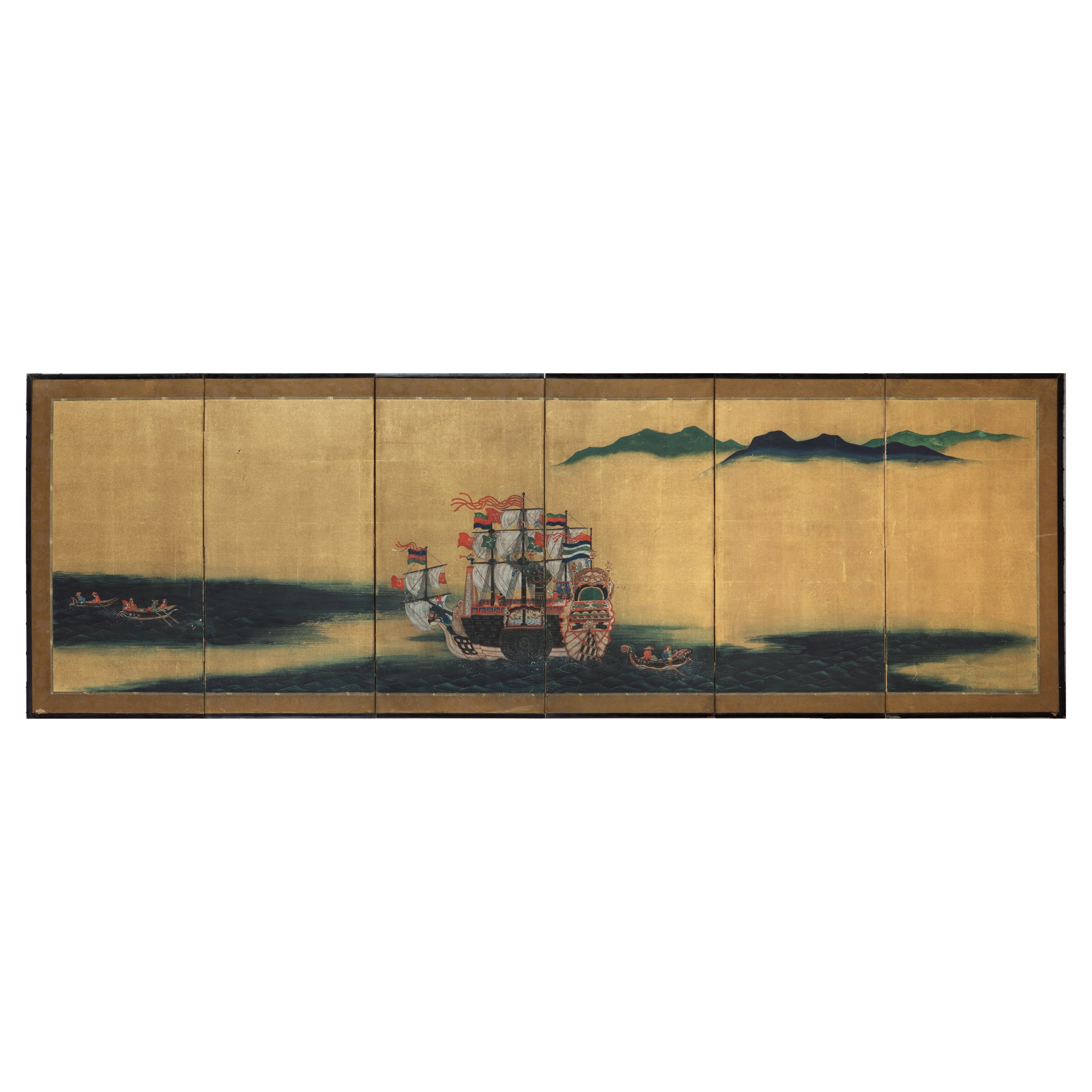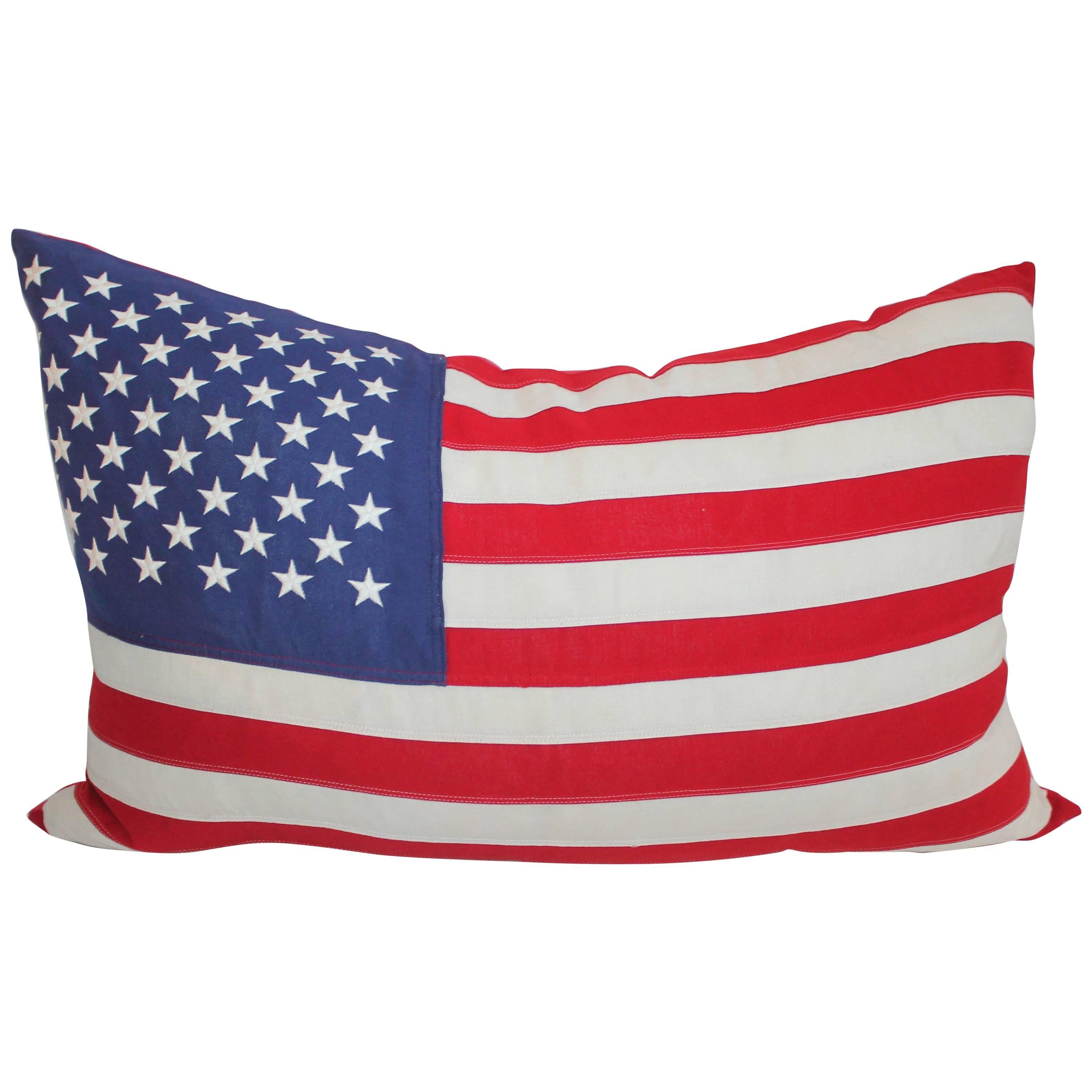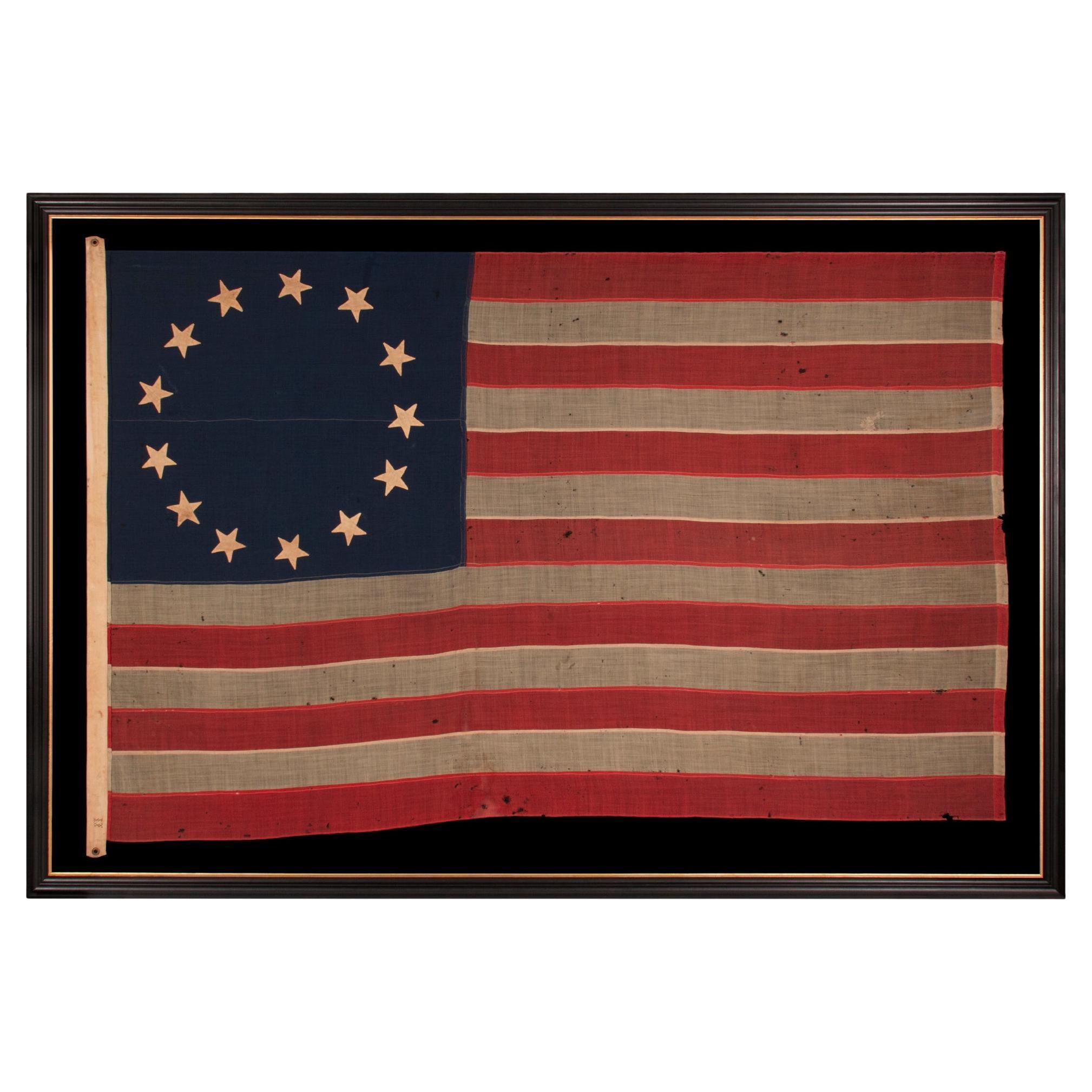Items Similar to 48 Star U.S Navy Jack Flown on the USS FT. Mandan, ca 1945
Want more images or videos?
Request additional images or videos from the seller
1 of 5
48 Star U.S Navy Jack Flown on the USS FT. Mandan, ca 1945
About the Item
48 STAR U.S. NAVY JACK, MARKED AS HAVING BEEN FLOWN ON THE U.S.S. FT. MANDAN, LAUNCHED NEAR THE END OF WWII, IN 1945, WITH SERVICE DURING BOTH THE KOREAN AND VIETNAM WAR ERAS, IN THE ARCTIC, AT THE NORTH POLE, AND AT GUANTANAMO BAY DURING THE CUBAN MISSILE CRISIS; FLOWN DURING THE EARLIEST POINT OF THE SHIP’S SERVICE, THE FLAG EXHIBITS ENDEARING WEAR FROM OBVIOUS USE
United States Navy jack with 48 stars, marked as having been flown on the U.S.S. Fort Mandan (LSD-21), launched near the end of WWII (U.S. involvement 1941-45). Named after the encampment along the Missouri River where the Lewis & Clark expedition spent the winter of 1804-1805, in present day North Dakota, the Mandan was a Casa Grande class dock landing ship, laid down on January 2nd, 1945, launched at the Charlestown Navy Yard, Boston, on June 2nd, 1945.
Like the British Royal Navy, American vessels flew three flags. When at anchor or moored, the jack is flown at the bow (front), the national flag or "ensign" is flown at the stern (back), and the commission pennant is flown from the main mast. When under way, the Jack is furled and the ensign may be kept in place or shifted to a gaff if the ship is so equipped.
The American Navy jack is a blue flag with a field of white stars. The design is the mirror image of the canton of an American national flag. In scale, the jack was meant to be the same size as the canton of the corresponding Stars & Stripes ensign with which it was flown. This particular example is made of wool bunting of an especially heavy grade, that has been bound with machine stitching. The stars are made of cotton and are double-appliquéd (applied to both sides) with a zigzag machine stitch. There is a heavy canvas binding along the hoist with four white metal grommets, along which “USS Fort Mandan; LSD 21; 1945” was inscribed with a felt tip pen.
The flag's construction, star count, and date notation all suggest that it was flown during the earliest points of the ship’s service. It was certainly flown for an extended time, as evidenced by the fact that so much of the fly end is absent. This is one of extremely few Navy flags I have seen that has actually lost stars—in this case an entire column. Endearing wear such as this is an extremely desirable feature, actually difficult to obtain in a flag that has, like this one, been legitimately flown in military service.
While the technical name for this type of flag is a "union jack," the confusing verbiage, being the same as the nickname of the most recognizable British flag, has resulted in a common shortening of the term to simply "the jack". Interestingly enough, the British Union Jack is not the proper name for that signal either. The design commonly called the "Union Jack" is actually the "Union Flag," though practically no one uses or is even familiar with the term. The only time that it can be properly called the "Union Jack" is when it is, in fact, flown as the jack on a British Navy ship. Because the British fly various national flags: the white ensign (Royal Navy), blue ensign (non-navy ships in public service), and red ensign (merchant ships), each of which is composed of a field with the corresponding color, with the Union Flag design as its canton, the use of the Union Flag as the jack on Royal Navy ships employs the same logic as using the blue field with stars (without the red and white striped field) as the American jack.
The Fort Mandan was a 458-foot, 7,930-ton vessel with a crew of 17 officers and 237 enlisted, capable of a speed of 17 knots. There were various types of dock landing ships, that served as dry docks from which all manner of equipment and troops could be brought onto a beach and deployed. 19 boats in this precise style were planned during WWII, though only 18 were actually built, 4 of which were sold to the U.K. (which had ordered 7 from U.S. dockyards).
Though launched during WWII, which ended on September 1st, 1945, the Ft. Mandan wasn’t commissioned until Halloween of that year (October 31st). During the Korean war it was employed in the Artic Circle, as well as in the service of atomic testing in Nevada. In 1953 it transported cannon, used to employ the only nuclear explosive fired as a projectile, from Nevada to Aberdeen Proving Grounds on the Chesapeake Bay. Spending a good deal of time in the Arctic, in 1955, post-war, it reached the North Pole, and in the same year, crossed the Equator for the first time. Traveling back and forth from the Caribbean to the Artic to the Mediterranean, in the opening year of the Vietnam War, 1961, it actually participated in the filming of the epic D-Day movie, “The Longest Day.” Many landing dock ships had been used to deploy troops and equipment at Normandy. In 1963 the Fort Mandan participated at Guantanamo Bay, during the Cuban Missile Crises. It was decommissioned shortly before the end of Vietnam, on the 23rd of January, 1971.
The 48 star flag became official in 1912 following the addition of New Mexico and Arizona. 48 remained the official star count throughout WWI (U.S. involvement 1917-18), WWII, and the Korean War (1950-53), until Alaska gained statehood in 1959 and the 49th star was added.
Mounting: The flag was mounted and framed within our own conservation department, which is led by expert staff. We take great care in the mounting and preservation of flags and have framed thousands of examples.
Mounting: The flag was mounted and framed within our own conservation department, which is led by expert staff. We take great care in the mounting and preservation of flags and have framed thousands of examples. The flag was hand-stitched to 100% silk organza for support throughout. It was then hand-stitched to a background of 100% hemp fabric, or a hemp and cotton blend (we use both interchangeably). The mount was placed in a deep, cove-shaped molding with a very dark brown surface, nearly black, and a rope-style inner lip, to which a flat profile molding, with a finish like old gun metal, was added as a liner. The glazing is U.V. Protective acrylic (Plexiglas). Feel free to contact us for more details. Condition: Extensive losses from obvious long-term use, including a full column of 6 stars absent, significant golden-brown oxidation, and significant soiling along the binding. Many of my clients prefer early flags to show their age and history of use.
Frame Size (H x L): 46.5" x 58.75"
Flag Size (H x L): 35" x 48"
- Dimensions:Height: 46.5 in (118.11 cm)Width: 58.75 in (149.23 cm)Depth: 2.5 in (6.35 cm)
- Materials and Techniques:
- Place of Origin:
- Period:
- Date of Manufacture:1945
- Condition:See Item Description.
- Seller Location:York County, PA
- Reference Number:
About the Seller
5.0
Recognized Seller
These prestigious sellers are industry leaders and represent the highest echelon for item quality and design.
Established in 1991
1stDibs seller since 2008
61 sales on 1stDibs
Typical response time: 10 hours
- ShippingRetrieving quote...Ships From: York County, PA
- Return PolicyThis item cannot be returned.
More From This SellerView All
- 48 Star Crocheted Homemade American Flag, WWII Era, 1941-1945Located in York County, PA48 star, crocheted, antique american flag of the wwii era (1941-1945), a beautiful, homemade example, with a red, white, & blue hoist and flower-like stars: Crocheted American fla...Category
Mid-20th Century American Political and Patriotic Memorabilia
MaterialsCotton
- 48 Star Antique American Flag, with Hand-Crocheted Stars, ca 1917-1918Located in York County, PA48 STARFISH-LIKE, NEEDLEWORK EXECUTED STARS ON A HAND-CROCHETED ANTIQUE AMERICAN FLAG FROM THE EARLIEST PART OF THE 48 STAR ERA, 1912-WWI (U.S. INVOLVEMENT 1917-18) OR EVEN PRIOR TO ...Category
Early 20th Century American Political and Patriotic Memorabilia
MaterialsCotton
- 13 Star Antique American Flag in the Betsy Ross Pattern, ca 1861-1865Located in York County, PA13 star antique American flag in the Betsy Ross pattern, one of just three examples that I have encountered that pre-date the 1890’s; an extraordinary find, civil war period (1861-1865) or just after, extremely large among its counterparts of all periods in this design: Exceptional, early, American national flag, with 13 stars arranged in the circular wreath pattern most often attributed to Betsy Ross. Since there was no official configuration for the stars of the American flag until 1912, when our nation received its 47th and 48th states, the design, before that time, was left to the whims of the maker. This led to an almost unimaginable spectrum of star arrangements on the American flag during the 18th and 19th centuries. Even within the 13 star count, alone, there are at least 80 known patterns—more than the average person would even think possible. 13 star flags have been made throughout American history, from at least June 14th, 1777, when the first Flag Act was passed by Congress, until the present. They have been continuously produced for reasons both patriotic and utilitarian. Because this was the original number of stars on the American flag, representing the 13 colonies, it was appropriate for any device made in conjunction with celebrations or notions of American independence. 13 star flags were thus displayed at patriotic events, including, but certainly not limited to, such occasions as Lafayette’s final visit, in 1825-26, the nation’s centennial in 1876, and longstanding celebrations of Independence Day. From at least 1840 onward, 13 star flags were produced for presidential campaigns, drawing a parallel between the past and present struggles for freedom, and were carried by soldiers, during the Mexican and Civil Wars, for the same purpose. Throughout history, and even today, they are boldly displayed at every presidential inauguration. 13 star flags were flown by American ships both private and federal. The U.S. Navy used 13 stars on the ensigns made for small boats, because they wished the stars to be more easily discernable at a distance. Private ships often copied Navy practice, and when commercial flag makers first began to produce flags with pieced-and-sewn construction, in small sizes, in large quantity, they frequently employed the 13 star count. Flags in the Betsy Ross design are widely admired, due to the longstanding popularity of the Ross family myth. While many Americans learned in grammar school that Betsy Ross made and designed our first flag, and that the stars appeared in a circular fashion, there is, unfortunately, no way to prove the claim. No colonial examples have survived with this pattern of stars. In fact, while arranging the stars in a single circle seems quite logical, among the various choices that might come to mind, early American flags with this star pattern are curiously absent. One of the interesting misconceptions about 13 star flags is that the Betsy Ross pattern, even if not the original design, must have been common in early America. Logic would suggest this, given the frequency with which it appears in modern times, but this isn’t actually the case. In fact, the pattern is seldom encountered anywhere until much later. In more than 30 years of buying and selling early Americana, and over 20 years of extensive focus on the American flag specifically, through aggressively buying, researching, evaluating, restoring, and curating exhibitions, I have thus far encountered just three examples of Betsy Ross pattern flags that I can confidently date prior to the 1890's. No one knows what the first flag looked like. While there is no precise reason that the Betsy Ross design could not have been the first, one of the best arguments against it, is illustrated by the simple fact that so many 13 star flags exist without it. If the Ross configuration was the original, it stands to reason that the pattern would have been reproduced with at least some degree of frequency. Research conducted by the National Museum of American History notes that the story of Betsy Ross making the very first American flag for General George Washington, in the company of George Ross and Robert Morris, entered into American consciousness about the time of the 1876 centennial. The tale was immensely popular among an American public eager for stories about the Revolution and its heroes. The first documentation of it appeared shortly beforehand, in 1870, in a paper written by Betsy’s grandson, William Canby, for the Pennsylvania Historical Society. At the time, Canby made no mention of how the flag was designed, save for the fact that it had 5-pointed stars, per his grandmother’s suggestion. Because no earlier documentation supports the story, most flag scholars feel it was a grand hoax, fabricated by Canby for his own interests. Nothing survives in the collective writings of the three men, for example, nor in records of their words and deeds, which are fairly extensive. As with most things, reality is perhaps somewhere in the middle ground, with some of the details based on fact and some on fiction, made up, misinterpreted, or imagined from family accounts. The first time that a star configuration gets attached to the Ross story appears to have occurred during the last decade of the 19th century. In 1892, Charles Weisgerber painted a nine-by-twelve-foot rendition of the fabled meeting between Betsy and George Washington, in which there is a flag with a circular wreath. Shortly afterwards, in 1898, Betsy’s granddaughter and great-granddaughter began to make flags in the East Wing of Independence Hall in Philadelphia, selling them to tourists while disseminating the family folk tale. In that same year, Weisgerber and a “group of concerned citizens” sought to preserve Betsy’s former Philadelphia residence at 239 Arch Street, where she lived at the time the flag would have been sewed. Weisgerber moved his family into the house and immediately opened to the public the room in which Betsy was said to have worked her magic. Ten-cent memberships were sold to fund renovations and donors received a small calendar, to which a cotton 13 star Betsy Ross pattern parade flag was affixed. The effects of these events caused the Ross legend to stick and the story, with the corresponding flag design, has appeared ever since in more places than one could ever hope to count. The stars of this particular flag are made of cotton, hand-sewn, and double-appliquéd (applied to both sides). The canton and stripes of the flag are made of wool bunting that has been pieced and joined with treadle stitching. There is a sailcloth canvas binding along the hoist, with two brass grommets, one each at the extreme top and bottom. Along this, on the obverse, near the bottom, are two, unusual characters, embroidered with brown thread. These may be letter “I’s,” possibly forming a the Roman Numeral “II.” They are followed by an inscription, in blue ink, that appears to read “A. N. Smith.” The first character is stylized, and may alternatively be a “D,” “H,” or perhaps a “J.” Note how the binding is extended beyond the top and bottom-most points. Though quite unusual, this is sometimes encountered in early examples. The folding of the wool bunting back onto itself, with the binding stitched so that part of the fold is exposed, tends to be an early characteristic. Common in Civil war flags...Category
Antique 1860s American Political and Patriotic Memorabilia
MaterialsCotton
- 13 Star Antique American Flag, ca 1895-1926Located in York County, PA13 STAR ANTIQUE AMERICAN FLAG WITH A 3-2-3-2-3 CONFIGURATION OF STARS ON AN INDIGO CANTON, SQUARISH PROPORTIONS, AND A BEAUTIFUL OVERALL PRESENTATION, MADE circa 1895-1926 This 13 s...Category
Antique Late 19th Century American Political and Patriotic Memorabilia
MaterialsWool
- 13 Star Antique American Flag , Ca 1890-1899Located in York County, PA13 STARS WITH SHORT, CONICAL ARMS ON A SMALL SCALE, ANTIQUE AMERICAN FLAG MADE DURING THE LAST DECADE F THE 19TH CENTURY; POSSIBLY OF PHILADELPHIA ORIGIN; FORMERLY IN THE COLLECTION ...Category
Antique 1890s American Political and Patriotic Memorabilia
MaterialsWool
- 13 Star, Betsy Ross Pattern Flag, Made by the Annin Company, ca 1955-1965Located in York County, PA13 STARS IN THE BETSY ROSS PATTERN, ON A VINTAGE AMERICAN FLAG, MADE BY THE ANNIN COMPANY OF NEW YORK & NEW JERSEY, circa 1955 - 1965 13 star American national flag, made entirely of cotton by the Annin Company of New York & New Jersey, in the period between approximately 1955-1965. The stars are arranged in the circular wreath pattern most often associated with Betsy Ross. Flags in this design are widely admired, due to the longstanding popularity of the Ross family myth. While many Americans were taught in grammar school that this was what our first flag looked like, there is, unfortunately, no way to substantiate the claim, and no colonial flags...Category
Late 20th Century American Political and Patriotic Memorabilia
MaterialsCotton
You May Also Like
- Vintage WWII U.S. Navy Patriotic Banner, "Welcome Firemen" Flag, circa 1941-1945Located in Colorado Springs, COThis is a beautifully preserved WWII Navy aircraft carrier banner, emblazoned with a welcome for the ship's firemen. The banner is partially printed and has sewn elements. The flag's field is dyed a rich navy blue, with a resist dyed white stripe and a sewn red stripe at both top and bottom. A large "WELCOME" is resist dyed at center, in big white letters. This is followed by a sewn yellow strip of contrasting fabric, printed with the word "FIREMEN" in blue. Thirteen white stars complete the design of this patriotic piece of WWII and Navy history. The banner retains its original white hoist, with two metal grommets on each side, for ease in display on the ship. Along the center of the hoist is the printed name of "J.S. Sullivan." "Naugatuck, Conn." is printed along the left and the size "2 x3 FT" is printed along the right. The flag maker, Annin, has sewn in its label, boasting "guaranteed defiance fast colors." CONDITION: Very good condition, considering age and past use. Partially printed and hand-sewn flag construction. Some toning to the white of the flag and along the top hoist. Original grommets at left and right of the hoist. The flag measures 36" X 22". Expertly framed on black linen with an antiqued black wood...Category
Vintage 1940s American Political and Patriotic Memorabilia
MaterialsLinen
- Japanese Screen Depicting USA Commodore Perry’s Flagship the USS MississipiLocated in Amsterdam, NLA rare and fine Japanese six-fold gold-leaf screen with the depiction of Commodore Matthew Perry’s flagship the USS Mississippi Early Bakumatsu period (1853-1867) Measures: H. 61 x W. 183 cm Provenance: Private collection, USA On 8 July 1853 Commodore Matthew Perry with his paddle-wheel warships USS Mississippi and Susquehanna, and two sloops, with a total of 65 guns and little less than 1000 man, for the first time arrived in the harbour of Shimoda, in the bay of Edo, in his own words, “to open doors of commerce, and spread civilization to a backward people, and also to spread the Gospel of God to the heathen.” In Japanese parlance, the American ships quickly became known as “black ships,” depicted as demonic monsters. For the Japanese, these huge coal-burning ships...Category
Antique Late 19th Century Japanese Paintings and Screens
MaterialsPaint, Paper
- Large 48 Star Embroidered Flag PillowBy American Flag & Banner Co.Located in Los Angeles, CAThis monumental 48 star flag pillow is in great in great condition and has a red cotton linen pillow. The big pillow id down and feather fill.Category
Mid-20th Century American Country Political and Patriotic Memorabilia
MaterialsCotton
- Early 20thc 48 Star Flag Hand Crochet PillowLocated in Los Angeles, CAThis fine hand crochet 48 star flag pillow is made with a blue velvet background or frame front and back.The insert is down & feather fill.Category
Early 20th Century American Adirondack Pillows and Throws
MaterialsWool
- Vintage Union Jack, Circa 1950sLocated in Colorado Springs, COThis is a beautiful Union Jack parade flag, dating from the early 1950s, during the early years of Queen Elizabeth II's reign. The flag is printed on cotton, with machine-sewn hemmed...Category
Vintage 1950s English Mid-Century Modern Political and Patriotic Memorab...
MaterialsCotton
- 46-Star American Flag Printed in Drum Star ConfigurationLocated in Colorado Springs, COThis is an original 46-Star American parade flag, celebrating Oklahoma statehood. Each star on the flag's canton represents a state in the Union at the time. The official flag design would update every July 4th, to include any new states added to the Union in the past year. Oklahoma, the 46th state, entered the Union on November 16, 1907. As such, this 46–star flag was the official flag of the United States from July 4, 1908, until July 4, 1912. The silk flag has a dark blue canton with 46 white printed stars. The stars are printed in an 7-8-8-8-8-7 row configuration, or “Drum design.” The flag design is completed with 13 alternating red and white stripes, each stripe representing one of the original thirteen colonies. The land that comprises Oklahoma today was added to the United States as part of the Louisiana Purchase of 1803. Throughout the 19th century, the U.S. government relocated Indian tribes from the southeastern United States to the area, and by 1900, over 30 Indian tribes had been moved to what was originally called the Indian Territories. At the same time, ranchers in Texas began to move into the area in search of new pasture lands. Although stipulations in the Indian Relocation Act agreed that the land would forever be Indian Territory, the promise of fertile farmland trumped the government’s promise of sovereignty. On April 22, 1889, they opened the land to settlement by homesteaders, creating a land run in which settlers, called “Boomers,” were allowed to cross the Texas or Arkansas border at a particular hour to claim homesteads. Settlers who illegally crossed the border earlier to stake prime land were called “sooners,” which eventually became the state’s nickname. Wagons and the Santa Fe railroad carried cartloads of men and women to blank town sites and building plots, creating ten thousand-people communities in a matter of days. The following year, the region was further divided into Indian Territory and Oklahoma Territory...Category
Vintage 1910s American Political and Patriotic Memorabilia
MaterialsSilk
Recently Viewed
View AllMore Ways To Browse
Commissioning Pennant
Arizona Flag
Blue And White Old Canton
Nettleton Road
Vote Democrat Quilt
Scandal Scandal Treatable
North Carolina Black Beard
Stars Stripes Flag
45 Star American Flag
Commissioning Pennant
Ship Shadowbox
45 Star Flag Large
Antique Flag Pole
Fante Applique
James Hayes
Suffragette Memorabilia
Vintage Cotton Union Jack Flag
Arizona Flag
